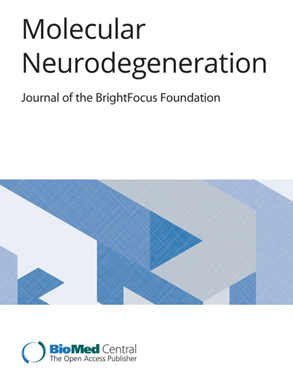Methylome analysis of FTLD patients with TDP-43 pathology identifies epigenetic signatures specific to pathological subtypes
IF 17.5
1区 医学
Q1 NEUROSCIENCES
引用次数: 0
Abstract
In the last decade, the importance of DNA methylation in the functioning of the central nervous system has been highlighted through associations between methylation changes and differential expression of key genes involved in aging and neurodegenerative diseases. In frontotemporal lobar degeneration (FTLD), aberrant methylation has been reported in causal disease genes including GRN and C9orf72; however, the genome-wide contribution of epigenetic changes to the development of FTLD remains largely unexplored. We performed reduced representation bisulfite sequencing of matched pairs of post-mortem tissue from frontal cortex (FCX) and cerebellum (CER) from pathologically confirmed FTLD patients with TDP-43 pathology (FTLD-TDP) further divided into five subtypes and including both sporadic and genetic forms (N = 25 pairs per group), and neuropathologically normal controls (N = 42 pairs). Case-control differential methylation analyses were performed, both at the individual CpG level, and in regions of grouped CpGs (differentially methylated regions; DMRs), either including all genomic locations or only gene promoters. Gene Ontology (GO) analyses were then performed using all differentially methylated genes in each group of sporadic patients. Finally, additional datasets were queried to prioritize candidate genes for follow-up. Using the largest FTLD-TDP DNA methylation dataset generated to date, we identified thousands of differentially methylated CpGs (FCX = 6,520; CER = 7,134) and several hundred DMRs in FTLD-TDP brains (FCX = 134; CER = 219). Of these, less than 10% are shared between pathological subgroups. Combining additional datasets, we identified, validated and replicated hypomethylation of CAMTA1 in TDP-A potentially also impacting additional genes in the locus. GO analysis further implicated DNA methylation in myelination and developmental processes, as well as important disease-relevant mechanisms with subtype specificity such as protein phosphorylation and DNA damage repair in TDP-A, cholesterol biosynthesis in TDP-B, and protein localization in TDP-C. We identify methylation changes in all FTLD-TDP patient groups and show that most changes are unique to a specific pathological FTLD-TDP subtype, suggesting that these subtypes not only have distinct transcriptomic and genetic signatures, but are also epigenetically distinct. Our study constitutes an invaluable resource to the community and highlights the need for further studies to profile additional epigenetic layers within each FTLD-TDP pathological subtype.具有TDP-43病理的FTLD患者的甲基组分析确定了病理亚型特异性的表观遗传特征
在过去的十年中,DNA甲基化在中枢神经系统功能中的重要性已经通过甲基化变化和涉及衰老和神经退行性疾病的关键基因的差异表达之间的关联得到强调。在额颞叶变性(FTLD)中,有报道称致病基因中存在异常甲基化,包括GRN和C9orf72;然而,表观遗传变化对FTLD发展的全基因组贡献在很大程度上仍未被探索。我们对病理证实为TDP-43病理(FTLD- tdp)的FTLD患者的额叶皮质(FCX)和小脑(CER)的配对死后组织进行了亚亚盐减少代表性测序,进一步分为五个亚型,包括散发性和遗传性形式(每组N = 25对)和神经病理正常对照(N = 42对)。在个体CpG水平和分组CpG区域(差异甲基化区域;DMRs),要么包括所有基因组位置,要么只包括基因启动子。然后对每组散发性患者的所有差异甲基化基因进行基因本体(GO)分析。最后,查询其他数据集以确定候选基因的优先级。使用迄今为止生成的最大的FTLD-TDP DNA甲基化数据集,我们确定了数千个差异甲基化的CpGs (FCX = 6520;在FTLD-TDP脑中,CER = 7134, DMRs数百例(FCX = 134;cer = 219)。其中,病理亚组之间共有的不到10%。结合其他数据集,我们鉴定、验证并复制了TDP-A中CAMTA1的低甲基化,这种低甲基化可能也会影响位点上的其他基因。氧化石墨烯分析进一步揭示了髓鞘形成和发育过程中的DNA甲基化,以及具有亚型特异性的重要疾病相关机制,如TDP-A中的蛋白质磷酸化和DNA损伤修复,TDP-B中的胆固醇生物合成以及TDP-C中的蛋白质定位。我们确定了所有FTLD-TDP患者组的甲基化变化,并表明大多数变化是特定病理性FTLD-TDP亚型所特有的,这表明这些亚型不仅具有不同的转录组学和遗传特征,而且在表观遗传上也是不同的。我们的研究为社区提供了宝贵的资源,并强调了进一步研究每个FTLD-TDP病理亚型中其他表观遗传层的必要性。
本文章由计算机程序翻译,如有差异,请以英文原文为准。
求助全文
约1分钟内获得全文
求助全文
来源期刊

Molecular Neurodegeneration
医学-神经科学
CiteScore
23.00
自引率
4.60%
发文量
78
审稿时长
6-12 weeks
期刊介绍:
Molecular Neurodegeneration, an open-access, peer-reviewed journal, comprehensively covers neurodegeneration research at the molecular and cellular levels.
Neurodegenerative diseases, such as Alzheimer's, Parkinson's, Huntington's, and prion diseases, fall under its purview. These disorders, often linked to advanced aging and characterized by varying degrees of dementia, pose a significant public health concern with the growing aging population. Recent strides in understanding the molecular and cellular mechanisms of these neurodegenerative disorders offer valuable insights into their pathogenesis.
 求助内容:
求助内容: 应助结果提醒方式:
应助结果提醒方式:


